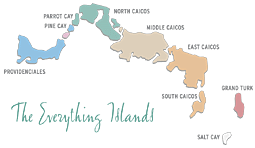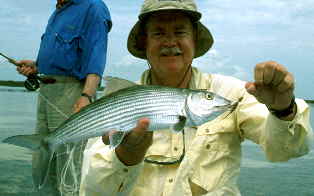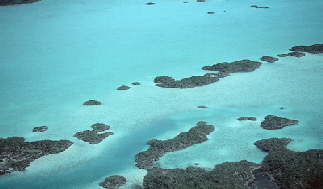|
Turks & Caicos' Backbay Bones
by Larry Larsen
 The Turks & Caicos Islands, a tiny country consisting of 30 small islands, lies snuggled
into the southeast corner of the Bahamas. They are practically unknown as a travel destination, yet thousands of "mud manging" bonefish roam the
numerous flats. In fact, the unspoiled islands may just have the world's best bonefishing. Of the two countries that share the Atlantic off Florida's coast, the Turks &
Caicos Islands obviously receive less publicity than do the Bahamas. Yet, the former is very accessible to visitors in the southeast. They lie 22 degrees north
latitude, equi-distant between the Bahamian Islands of Mayaguana and Great Inagua. The Turks & Caicos Islands, a tiny country consisting of 30 small islands, lies snuggled
into the southeast corner of the Bahamas. They are practically unknown as a travel destination, yet thousands of "mud manging" bonefish roam the
numerous flats. In fact, the unspoiled islands may just have the world's best bonefishing. Of the two countries that share the Atlantic off Florida's coast, the Turks &
Caicos Islands obviously receive less publicity than do the Bahamas. Yet, the former is very accessible to visitors in the southeast. They lie 22 degrees north
latitude, equi-distant between the Bahamian Islands of Mayaguana and Great Inagua.
The most accessible and beautiful of the Turks & Caicos islands is Providenciales. The
commercial jet traveler from Miami can reach the great "Provo," as it's commonly called, in
about 1 1/2 hours. For boaters, Provo is an interesting trip. The boater's longest crossing without sight of land would be the Gulf Stream to reach the Bahamas Bank from either
West Palm Beach or Miami. From there, it's just a matter of island hopping to Provo. We flew into the Turk & Caicos one afternoon, transferred to the beautiful Club Med Turkoise
and were ready the following morning for our bonefish adventure. Our guide, Barr Gardiner, met us at the pool/lobby area and gave us a little insight on what to expect on our way to the marina.
"Bonefish are fairly easy to locate year around. They are bottom feeders, and as they
forage for crabs on the bottom, they kick the mud up," he explained. "If the sun shines on the water and the wind creates just a little wave movement, you can easily spot them a
couple of miles away. Bonefish are always feeding."
We boarded Captain Gardiner's skiff and, within minutes, we were headed out of the
"Leeward Going Through" Pass. We passed the geodesic dome of the Conch Farm, the world's first mariculture project of its kind, and headed across the Caicos banks to an area
about 8 miles from the marina. Conditions were tough. High winds churned up the flats, which varied in depth from three to six feet. In the distance, thunderstorms seemed to be
coming our way. We immediately noticed that the wind was attempting to push waves in one direction while the tide was running out in another. The first bonefish school we
encountered was headed yet in a different direction.
 Looking for Mud Wrestlers Looking for Mud Wrestlers
Our experienced guide effortlessly spotted the "muds" where bonefish were actively feeding and stirring up further the roily waters. We had
difficulty them seeing initially. Even under those conditions, a 3 1/2 pounder sucked in the first cast of the morning. The drag sung a tune often
heard on the flats as the bone seemed headed southwest toward a Bahamian island.
Five minutes and 80 feet of stripped line later, the fish was well under control. At boatside, Captain Gardiner netted the silvery streaker,
and we motored back above the mud for another drift. Our small jigs were tossed into the disturbed water, but we each missed a strike as the boat again drifted quickly by the fish on
the leading edge of the mud. After the quick success of our first cast, we thought that catching the "average 30 bones a day " would be easy. We gave up on the first mud and
searched the flats for the next sign of a school of feeding bonefish. With the weather conditions less than hospitable, it took 25 minutes to find another mud.
Shortly afterwards, Gardiner found a second mud that he estimated to contain about 1
,600 bonefish. A circling gull helped to pinpoint the leading edge of the huge, 1/4-mile-long mud. Slowly we motored to the moving front and cast our bucktail jigs. We picked up
another bonefish before drifting by the apparent feeding frenzy. The high winds continued to make it difficult to stay on the fish.
High Seven in the Winds
The most productive bonefish areas in the flats appeared to be those that were the
most stirred up. We finished our 3-hour trip with seven bonefish, not bad under those conditions according to Gardiner.
"It's better fishing when it's calmer because anglers can work the jigs more thoroughly
without drifting by the school as fast," explained our guide. "May and November are the rainy, windy months, but the fish can be caught year round. Summertime is considered the
better season due to more stable weather conditions," he added.
Gardiner prefers to fish the Caicos Banks on the southern side of Provo on half day trips
because it's closer to the marina. On a full day charter, the guide often chooses to wade waters 8 to 10 inches deep and search for tailing bonefish. "We don't always fish from the
boat," he says. "On full day trips, we fish from the boat in the morning, have lunch, and then wade fish the real shallow water in the afternoon. Even in windy conditions, the
bonefish will move in close to the island on the lee side."
Most of his clients, however, are not as successful at catching the elusive bones when
wading. It takes a while to learn how to sight a fish "tailing" in the shallows, and naturally
it's easier at low tide. But Turks & Caicos bonefish aren't bashful. On very calm days, they
are often found close to all Provo shores, but that doesn't mean bonefish are easy to catch.
 Provo Forecasting Provo Forecasting
The weather on Provo is similar to most islands within 600 miles of Florida. Cold fronts bringing rainy windy weather are frequent
during the winter months. Abrupt barometer changes though, are not good for every day fishing.
When a front approaches, the wind normally changes to the west and northwest.
It usually takes about eight hours for the front to clear. Then, it will blow from the northeast for a day offering bone fishermen the lee shore. The predominant wind is from
the southeast about 95 percent of the time. Provo year-round temperatures generally rise to the mid 80's during the day and fall into the 70's at night. Winter and summer extremes
vary little from that. Naturally, the waters control the air temperature more than the land does, and its temperature seldom varies more than six degrees.
Turks & Caicos in general, and Providenciales in particular, are the kind of obscure
islands one dreams of when planning a tropical vacation. Club Med Turkoise is the type of fun-filled, modern accommodations near the excellent bonefishing that one would wish for.
A full day of bonefishing in the morning, a shore lunch, then some afternoon snorkeling or wading in the flats is the kind of activity that is possible to do because of the availability of
beaches, and the ease of finding a secluded angling spot to yourself.
The bonefish flats off Provo are unlike most any others found in the Gulf, Keys or the
Caribbean - they're full of the battlers. Bone "barracks" are everywhere on the Caicos Bank, and you can bank on that!
|